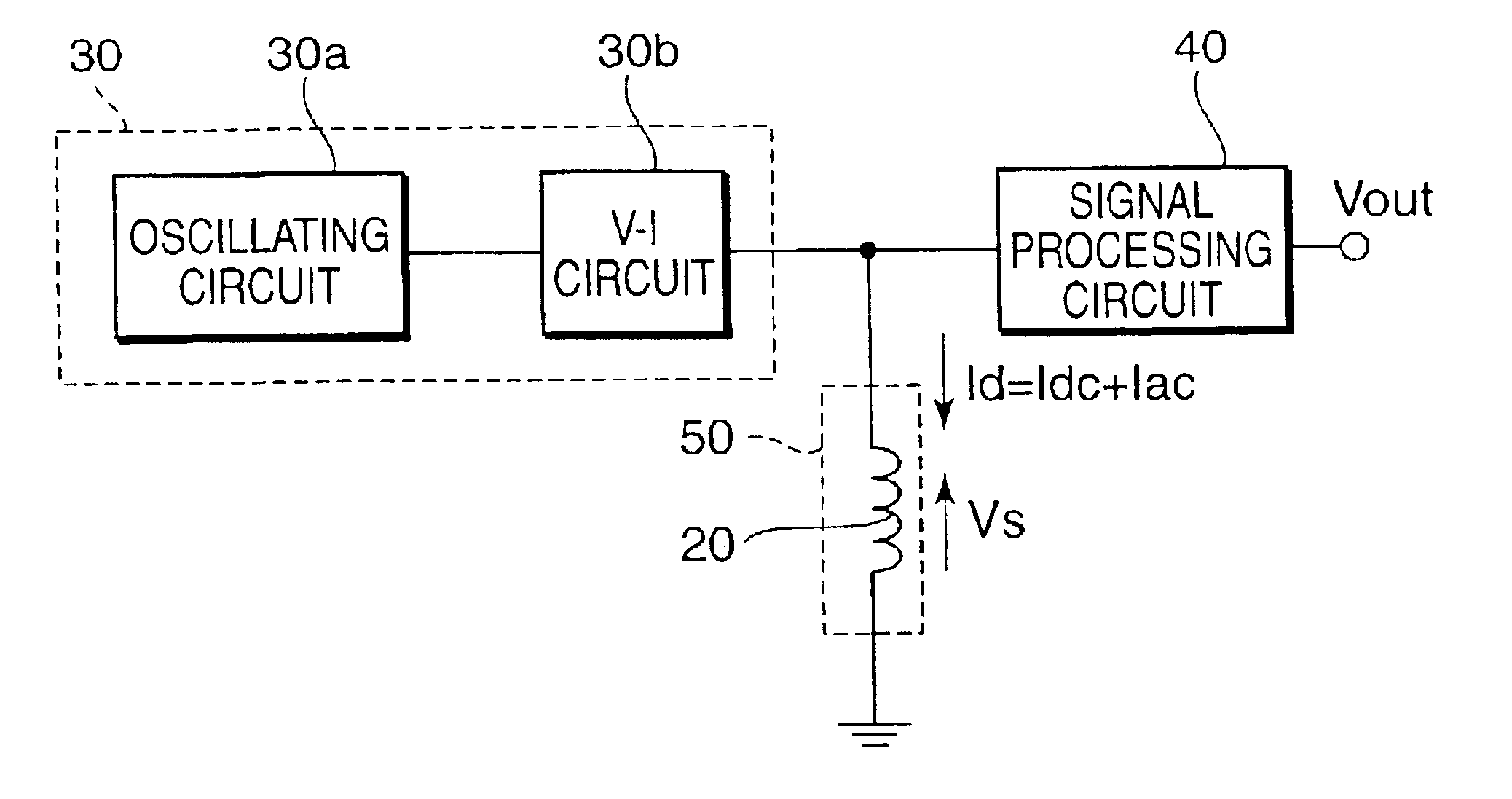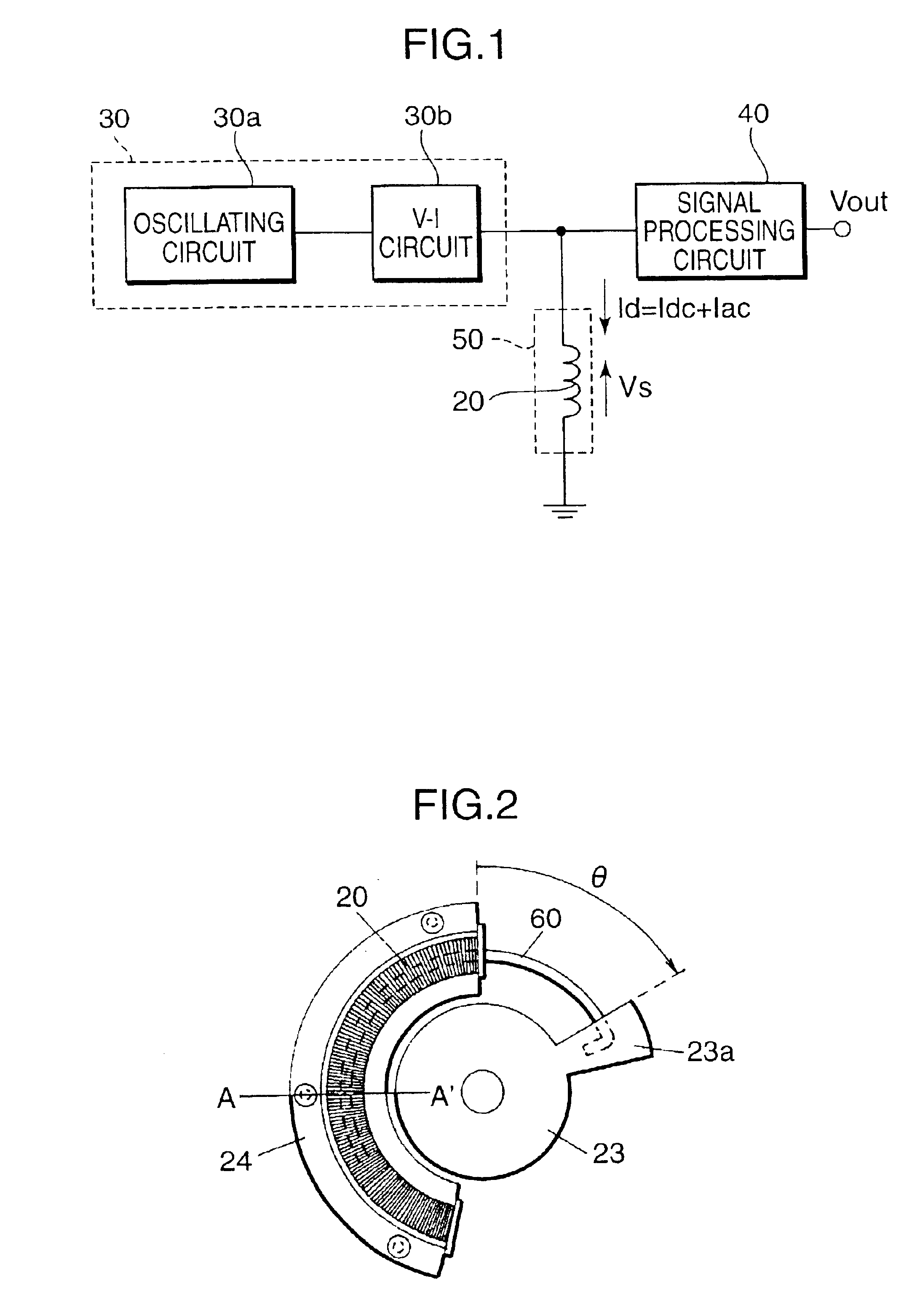Position sensor to compensate for change of temperature coefficient of impedance of a detection coil
a technology of temperature coefficient and detection coil, which is applied in the field of position sensors, can solve the problems of increasing the number of parts difficulty in positioning parts relative to other parts, and complicated circuit configuration of the position sensor, so as to simplify the circuit configuration and reduce the dependence of the temperature coefficient of the detection coil on the displacement of the cor
- Summary
- Abstract
- Description
- Claims
- Application Information
AI Technical Summary
Benefits of technology
Problems solved by technology
Method used
Image
Examples
first embodiment
[0056]FIG. 1 is a diagram showing a circuit configuration of a position sensor in accordance with the first embodiment of this invention. FIG. 2 is a top plan view of the position sensor. FIG. 3 is a sectional view taken along the line A-A′ in FIG. 2. FIG. 4 is a sectional view of a detection coil 20.
[0057]The position sensor in accordance with the first embodiment has a generally U-shape in section, and comprises the detection coil 20, a movable block 23, a core 60, a curvature corrector 24, a housing 25, a constant current circuit 30, and a signal processing circuit 40. The detection coil 20 is produced by winding a wire around a curved bobbin 22 which has a given curvature. The curved bobbin 22 has a generally U-shape in section and is applied with a coating 21 on the inner surface of the U-shaped portion thereof. The movable block 23 is a cylindrical body having an axis of rotation coaxial with the center of the curved detection coil 20 with a protrusion 23a formed at an outer p...
second embodiment
[0095]In this embodiment, described is a temperature compensation method for keeping the temperature characteristic of impedance Z of the detection coil 20 from being affected by relative displacement of the core 60 to the coil 20 by setting a state where the value of Δ(dZac / dT) is minimized as an ideal state. The arrangement of the position sensor in this embodiment is substantially the same as that in the first embodiment. Accordingly, elements in the second embodiment which are identical to those in the first embodiment will be denoted at the same reference numerals, and description on the identical parts will be avoided.
[0096]As a first temperature compensation method, described is a method for matching the temperature change ratio of impedance Z of the detection coil 20 in the case where the core 60 is not passed through the detection coil 20 with the temperature change ratio thereof in the case where the core 60 is passed through the detection coil 20.
[0097]Impedance Z of the ...
third embodiment
[0111]In this embodiment, a method of improving linearity of output is described. The construction of the position sensor in accordance with the third embodiment is substantially the same as that in the first and second embodiments. Accordingly, elements in the third embodiment which are identical to those in the first and second embodiments will be denoted at the same reference numerals, and description on the identical parts will be avoided.
[0112]A first linearity improving method is to select an appropriate material for the core 60 and to set the frequency f of the alternate current Iac appropriately. The inventors of this invention carried out experiments concerning linearity of AC impedance Zac by changing the material of the core in relation to the detection coil 20 which has been exemplified in the first embodiment. FIG. 19 shows a list of the used metallic materials: soft magnetic iron, permalloy, electromagnetic stainless, SUS430, and iron chrome, and corresponding estimate...
PUM
 Login to View More
Login to View More Abstract
Description
Claims
Application Information
 Login to View More
Login to View More - R&D
- Intellectual Property
- Life Sciences
- Materials
- Tech Scout
- Unparalleled Data Quality
- Higher Quality Content
- 60% Fewer Hallucinations
Browse by: Latest US Patents, China's latest patents, Technical Efficacy Thesaurus, Application Domain, Technology Topic, Popular Technical Reports.
© 2025 PatSnap. All rights reserved.Legal|Privacy policy|Modern Slavery Act Transparency Statement|Sitemap|About US| Contact US: help@patsnap.com



